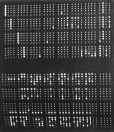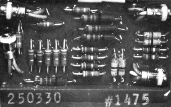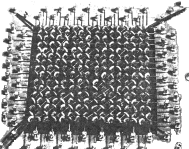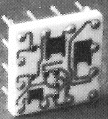

major technology jumps
Massive construction, vacuum tubes, generally discrete components, relatively slow speeds. Here are some technologies used:
 |
Vacuum tubes -- the primary electronics componenet in early systems of the 1940s, such as ENIAC and Colossus. Essentially, a vacuum tube is an electronic switch. Depending on whether a current is put on its switching connection, it may or may not allow a current to cross its other connections. |
 |
Williams tube storage screen (for more, see the Bizzare and British page) -- probably the first reasonably large-scale, reasonably reliable, reasonably fast memory. There were other forms of electrostatic memory in use in the late 1940s, when core memory appeared on the scene. |
The introduction of the transistor, invented in 1947 by John Bardeen, Walter H. Brattain, and William B. Shockley at Bell Labs, made it possible to replace bulky, unreliable vacuum tubes by transistors, which performed the same function, and used much less power. Although transistors were the big breakthrough of the second generation, core memories were also a critical component of the improved reliability of this generation -- and persisted into the third generation.
 |
Early transistors were implemented as single components on a logic board, such as this example from 1960; miniaturization followed soon, with the third generation. (The transistors are the four larger parts with three connectors; the striped cylinders are resistors.) |
 |
Core memory, invented by Jay W Forrester in 1949, became the mainstream memory of the 1950s, and was still in use in the late 1970s. A magnetic material can have its magnetization altered by an electric field. If the field isn't strong enough, the magnetism is unchanged. This principle makes it possible to change a single piece of magnetic material -- a small doughnut called a core -- wired into a grid, by passing half the current needed to change it through two wires that only interesect at that core. Later cores were barely visible to the naked eye, unlike this early example. |
The third generation introduced increasing miniaturization through combination of many components in small, reusable packages. The integrated circuit (IC) and hybrid circuits (discrete components packaged together in one plug-in module) started to appear, around the mid-1960s. The crucial breakthrough was the development of a new process called planar technology at Fairchild Semiconductor, in 1959, by Jean Hoerni and Robert Noyce.
 |
This early (1965) example of a module containing transistors in the form of chips on a miniature printed circuit illustrates the first stage towards the development of the IC. |
 |
Soon after, the monolithic IC appeared, in which the whole circuit was on a single chip. The IC below in this picture has its external packaging removed so the chip and its connectors are visible. The IC above it has the familiar black packaging and twin row of connectors, still seen in ICs 30 years later. |
The current generation of computers, in which ICs are on a much larger scale than before, and memory is also based on chips, has resulted in computers becoming much more widely accessible. Today, it's possible to buy a computer for under $1000 that makes the giants of the 1940s and 1950s seem like toys.
For more on the history of core, see C Evans. Conversation: Jay W. Forrester, Annals of the History of Computing, vol. 5 no. 3, July 1983, pp 297-301.
PBS has a web site featuring history of the transistor.
Visit Micron's history of semiconductors.
| Memories are Made of This 17:30 Thurs 12 September 1996 SHB5, Senate House, University of the Witwatersrand, Johannesburg, South Africa |
